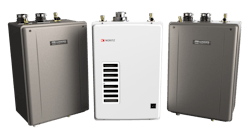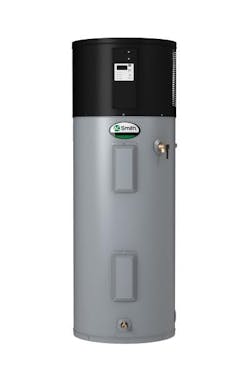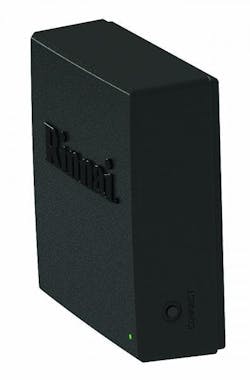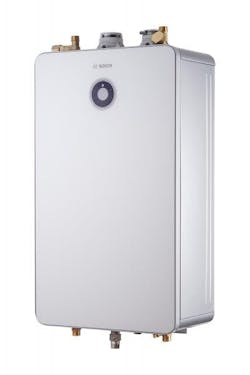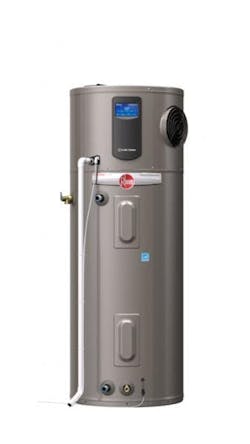Heating Up: Water Heater Efficiency, Innovations Continue to Grow
A water heater is the type of product that most homeowners don’t think about until there’s a problem. But there are many reasons building pros should keep water heaters top of mind. In both tank and tankless models, manufacturers have been innovating in ways that have dramatically increased efficiencies, extended life spans, and increased accessibility.
“What we’re finding is builders are wanting to create differentiation, and in many cases they’re turning to the water heater to do that,” says David Chisolm, vice president of marketing for A.O. Smith.
The company recently upgraded its Voltex hybrid electric heat pump units for use in all climates and has added a duct kit accessory for installation in small spaces. Energy Star-qualified, the units feature four operating modes that match heating requirements to environmental conditions.
Overall, tankless units continue to come on strong, says Joe Holliday, senior director of business and product development at Rinnai, with gas tankless units growing by double digits.
Tankless models, which heat water on demand, can be 24 to 34 percent more energy efficient than traditional storage models in homes using 41 gallons of hot water a day, according to the Dept. of Energy. Many tankless units offer efficiency levels in the high 90s, says Chisolm, thanks in part to newer condensing technology, which adds a secondary heat exchanger.
On-demand units do come at a higher price, but it’s a cost that may be offset by energy savings and a longer life span, the DOE notes. They also offer the convenience of endless hot water, when sized appropriately. Tankless units require a larger gas line and, if they feature condensing technology, will need a separate dripline.
The manufacturer now offers Control-R, a wireless module for demand recirculation. Wireless push buttons mounted near the point of use, such as a kitchen faucet or bathroom sink, operate the tankless unit’s recirculation system, thereby reducing wait time and wasted water. The wireless module pairs with a Rinnai mobile app, allowing homeowners to enable maintenance alerts and communications with an independent dealer.
Specifying a tankless unit in new construction is straightforward, but switching to tankless in retrofi t applications may be more difficult depending on the location of the existing unit and whether rerouting of gas lines or changes in venting are needed. Tankless manufacturers are taking that into consideration and developing models specifically for existing homes. Noritz, for example, offers a unit with water lines on the top, which coincides with tank units.
In exchange for a lower price point, traditional tank units are less energy efficient due to standby losses. Manufacturers are reducing those losses and meeting tougher requirements by increasing the insulation around the tank. Gas storage models can qualify for Energy Star with an Energy Factor of .67 or higher for 55-gallon and smaller units and greater than .77 for larger tanks.
Electric “heat pump” or “hybrid” models are the most efficient tank-type options. These integrate a compressor and heat exchanger into the unit, using the ambient air to help heat the water. The units cost about twice as much as traditional electric tank units, but, at twice the efficiency, have a payback of less than two years.
The Greentherm 9000 Series of tankless water heaters comprises nine models with an Energy Factor of .99 and a thermal efficiency of 100 percent. The units have a built-in recirculation pump for plug-and-play installation of a home recirculation system. An active bypass provides temperature stability and eliminates the need for a buffer tank.
INNOVATIVE OPTIONS
With Americans more conscious of water conservation, recirculation pumps, which bring hot water to the point of use quicker to prevent waste, are becoming more common. Increasingly, both tank and tankless units feature built-in recirculation buttons or integrate with existing systems.
In addition, many builders are pushing to locate water heaters centrally in the house and closer to fixtures.
Similar to other product categories, water heater manufacturers are also jumping into smart controls, with several launching wireless capabilities this year that work with users’ smartphones and communicate with service providers.
“The latest water heating innovations include better technology to make water heaters more intelligent than ever before,” says Stacey Gearhart, director of product and channel marketing for Rheem’s water heating division. Featuring EcoNet, Rheem’s new Prestige Series hybrid electric water heater sends a notification to a smartphone and sets off an alarm if a leak is detected.
Prestige Series hybrid electric water heaters reduce hot water energy use by up to 73 percent versus traditional units, the company says. The model offers Energy Saver and high-demand modes to provide more hot water when needed while using less energy, built-in leak detection, and quiet operation. The EcoNet system allows homeowners to control the water heater via smartphone.
Noritz is introducing a wireless adapter in May that is backwards compatible to existing units. Bosch will unveil Wi-Fi capabilities later this year that will “communicate with the water heater,” says trainer Chas Kerin, “but more importantly, the water heater can go onto the Internet and link to a Bosch server where a remote technician can look at the unit and help to troubleshoot or service it.”
For builders and remodelers trying to decide on a product for clients, it’s best to talk through it with a dealer or manufacturer that can weigh the homeowners’ lifestyle needs and energy goals. A.O. Smith has a selection tool on its website that asks simple questions to help match buyers with the most appropriate unit.
“Builders should also pay close attention to the local, state, and federal regulation codes to figure out which product will help comply with the rules and regulations,” notes Gearhart.
“It used to be tank vs. tankless,” says Chisolm. “Now there’s a range of solutions. Condensing tank, condensing tankless, solar, etc. It comes down to how is the builder positioning himself in the marketplace, who are his customers, and what will resonate best.”
This story originally appeared in the March/April 2017 issue of PRODUCTS magazine. See the print version here.
